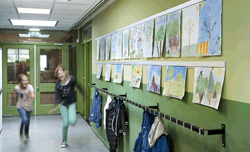by Dave Veilleux, VP Business Development -
 Currently “Cork Rail” is the de facto standard product on which school designers rely for hanging children’s art, displaying students’ work, mounting wall posters, for use as map rails, and posting staff notifications. But there are multiple reasons to reconsider this type of art rail.
Casso Display Rail is not cork-based, so there is no use of (or concern with) sharp objects to display items. Also, because it requires no “fasteners”, it is “always ready” for use. There is never the need to remove a collection of staples from the last showings or to locate a fresh supply of thumb tacks. Simply insert flat documents/art into the bottom of the track. There they hang. Effortless!
It is also very tolerant of flat document thickness. It is compatible with single sheets and even 2-ply and 4-ply mat boards up to 1/16 inch thick (2mm). Versatile!
Because the surface is hard anodized satin aluminum and not porous, there is less chance of graffiti or markings adhering to Casso Display Rail, keeping it looking clean and pleasing. Few shinanigans here. It plays nicely!
Since there are no adhesives and no sharps repeatedly puncturing the holding mechanism, there is less wear-and-tear on Casso Display Rail. By the way, if the insert were to fail, replacement is easy. Facility Engineers love this! This is a good time to state Casso Rail ships with all needed mounting hardware and end caps are included. More love!
And the mounting hardware is hidden from view. The sleek lines are permanent so cleaning and dusting is equally carefree. Who doesn’t like that?
As for “map clips”, well, we don’t offer those. Heck, the entire rail is a map-hanging surface. Map clips aren’t needed. Instructors love that!
As you can see from the photo above, objects are mounted into the bottom of Casso Display Rail. The little fingers built into the gripper mechanism flex to grasp inserted display material. These behave much like the flexible grippers on windshield wipers when wiping a wet surface. The fingers “grab” a little bit more the farther they are pressed against a surface. The thicker the material the harder the fingers grasp, up to 1/16 inch. Easy!
Currently “Cork Rail” is the de facto standard product on which school designers rely for hanging children’s art, displaying students’ work, mounting wall posters, for use as map rails, and posting staff notifications. But there are multiple reasons to reconsider this type of art rail.
Casso Display Rail is not cork-based, so there is no use of (or concern with) sharp objects to display items. Also, because it requires no “fasteners”, it is “always ready” for use. There is never the need to remove a collection of staples from the last showings or to locate a fresh supply of thumb tacks. Simply insert flat documents/art into the bottom of the track. There they hang. Effortless!
It is also very tolerant of flat document thickness. It is compatible with single sheets and even 2-ply and 4-ply mat boards up to 1/16 inch thick (2mm). Versatile!
Because the surface is hard anodized satin aluminum and not porous, there is less chance of graffiti or markings adhering to Casso Display Rail, keeping it looking clean and pleasing. Few shinanigans here. It plays nicely!
Since there are no adhesives and no sharps repeatedly puncturing the holding mechanism, there is less wear-and-tear on Casso Display Rail. By the way, if the insert were to fail, replacement is easy. Facility Engineers love this! This is a good time to state Casso Rail ships with all needed mounting hardware and end caps are included. More love!
And the mounting hardware is hidden from view. The sleek lines are permanent so cleaning and dusting is equally carefree. Who doesn’t like that?
As for “map clips”, well, we don’t offer those. Heck, the entire rail is a map-hanging surface. Map clips aren’t needed. Instructors love that!
As you can see from the photo above, objects are mounted into the bottom of Casso Display Rail. The little fingers built into the gripper mechanism flex to grasp inserted display material. These behave much like the flexible grippers on windshield wipers when wiping a wet surface. The fingers “grab” a little bit more the farther they are pressed against a surface. The thicker the material the harder the fingers grasp, up to 1/16 inch. Easy!